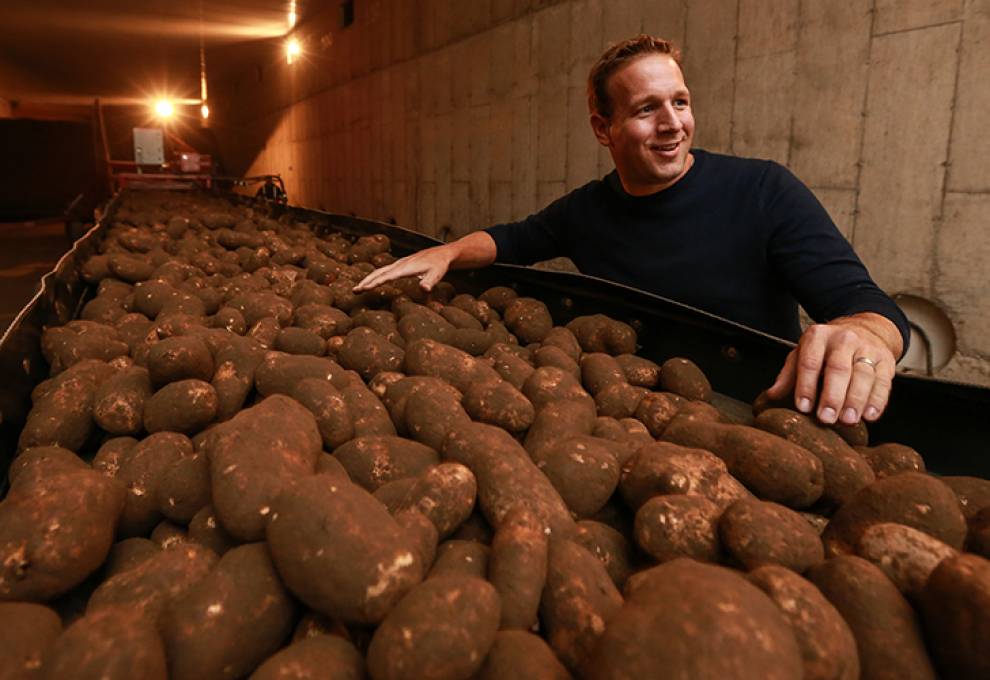
OFVGA’s summer tour was aptly named: Exploring the dirt on potatoes. It almost required boots on the ground in the Alliston and Shelburne, Ontario areas. Much needed rain prior to the August 18 summer tour prevented in-field inspections. However, industry participants enjoyed an in-depth perspective of both fresh table and chipping potatoes grown on 34,800 acres in Ontario.
Topics ranged from wash-water management strategies to late blight control experiments to breeding trials. The potato industry is continually innovating with value-added products and novel packaging.
No tour is complete without taste tests. Thanks to The Chippery for freshly fried crisps and Beattie’s Farm Distillery for potato vodka samplers.
Downey Potato Farms
A decade of experience in growing organic potatoes hasn’t made this season any easier.
“It’s been trial and error working through drought,” says Trevor Downey, Melancthon, Ontario. As a certified organic producer through ProCert, Downey explains that organic farm management practices echo the 1950s and 1960s. Remember a scuffler? This piece of equipment is used once and sometimes twice a week to control weeds. This summer, three weeds have emerged to be particularly troublesome: Canada thistle, lamb’s quarters and milkweed.
“What we’re learning this year is to employ more labour for weed control,” says Downey, speaking about 50 acres of organic potatoes. “We’ve got four people weed whacking for milkweed.”
One trick is to top the milkweed before a rainfall. Once moisture gets inside the stem, the plant will rot and die. This has been hard to execute in a droughty year.
“We’re getting more labour-intensive versus equipment-intensive in growing organics,” says Downey. It’s a case of analyzing the input costs. Compared to conventional seed, organic seeds are more expensive as are biological controls.
The good news is that ladybugs are doing a good job of controlling the larvae of Colorado potato beetles as well as leafhoppers. It’s a fine balance.
At the end of the season, Downey expects his 50 acres of organic potatoes to yield about 200 cwt/acre. That’s well below the 300 cwt/acre that he achieves with conventionally grown potatoes on the rest of his farm.
Sunrise Potato Storage Limited
All farmers are researchers but few are more studious than Peter VanderZaag. For the last 20 years, he’s focused on a plot of land that’s prone to potato scab and trialled parental lines and their progenies for resistance to common scab. Potato scab bacteria attack tubers for their moisture and flesh, often pitting the potato and rendering it unmarketable.
“We’re making good progress with this multigene trait,” says VanderZaag, president of Sunrise Potato, Alliston, Ontario. He credits Cornell University’s plant breeder Robert Plaisted with mentorship on his life’s work.
Potato breeding is time-consuming. Potatoes have attractive flowers which are naturally self-pollinated and then form berries which contain 200 to 300 true seeds. By cross pollinating between parents there is the promise of thousands of new varieties, which must be grown out for several generations to determine their vigour and value under various environmental conditions.
In addition to looking for scab resistance, Vander Zaag doesn’t want to lose sight of producing a white chipping variety that stores well into winter. This is no easy task looking for concurrent, but not necessarily related traits.
In today’s continental potato market, seed flows easily from east to west and north to south, however this free movement results in new subspecies and strains of potato scab hitching a ride. “Seed movement is so common that we’ve made it worse for ourselves when it comes to this disease,” says Vander Zaag.
Farmers are tempted to solve the potato scab issue by fumigating soil. But with fewer products on the market, this expensive practice will not be sustainable into the future.
Vander Zaag is undaunted in his search for a breeding solution. In fact, he’s recently shifted efforts to finding germplasm that’s resistant to late blight as well. These plant breeding efforts include collaborators such as Robert and Joyce Coffin, private breeders from Prince Edward Island.
No doubt there will be a day in the future that potato growers will thank these soldiers for their untiring efforts.
For a fascinating glimpse of ongoing research, click here and watch the video: Selection of New Varieties for Scab Resistance and Good Processing Qualities.
Tupling Farms Limited
By taking care of the land, the land is taking care of Bert and Pat Tupling, their sons Andrew and Aaron and families. Depending on the parcel of land, potatoes may be rotated into either corn, wheat or barley.
We’re getting to a place where potatoes are planted once every three years,” says Bert Tupling, Shelburne, Ontario.
This commitment to soil fertility requires ownership and long-term rentals of close to 4000 acres of land. Do the math and about 1,600 acres is planted to potatoes in a given year.
“We’re positive about the future of fresh table potatoes,” says Tupling. Part of that optimism stems from on-farm research trials which yield advance knowledge of better varieties. Will this variety store? Will this variety yield for the fresh table market? Those are the questions that need to be answered when input costs are as much as $3,000 per acre.
The Tupling family delivers fresh potatoes to many markets in southern Ontario, directly to wholesalers or warehouse facilities. It’s a competitive marketplace given that fresh potatoes may come from neighbouring provinces or the western United States.
Ontario’s droughty summer has reduced yields by 25 to 30 per cent so the recommended price by the Ontario Potato Board has just gone up to $3.00/10 lb as of August 10.
Since Ontario potato growers fill about 65 per cent of the province’s demand, there’s not much room to increase prices to reflect local growing conditions. As the 2016 crop is harvested, watch for any price tweaks. It’s a delicate balance between supply and demand, especially given the recent headlines that retailers are seeking lower prices from suppliers.
Beattie’s Farm Distillery
Being fifth-generation potato farmers doesn’t make it any easier to start a value-added business. Ken and Liz Beattie have spent more than two years planning the construction of an on-farm distillery and marketing program near Alliston, Ontario. The early success of their farm-crafted potato vodka is measured in the fact that it’s already in 300 stores of the Liquor Control Board of Ontario (LCBO).
“We currently have a 750ml bottle in production but are now looking to a 1.14ml bottle,” says Liz Beattie. “The goal is to be across Canada before we explore export markets.”
True to their rural roots, 50 cents of every bottle sold will be donated to local charities.
The distilling process is currently offsite but will be brought home soon with the arrival of a German-made, 5,000-litre still pot. At capacity, it can churn out 250 to 300 cases per day. One of the benefits of choosing to “cook” and ferment potatoes is that, unlike other alcohols, aging is not required.
“We are in the process of making a potato whiskey that could be marketed by Christmas,” says Beattie.
With in-store demonstrations underway from Oakville to Ottawa, the brand is set to take off. Cheers to farm-crafted vodka.

Add new comment